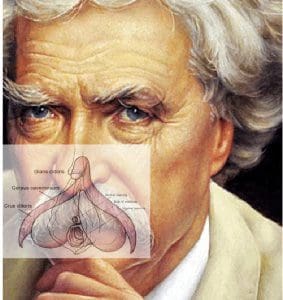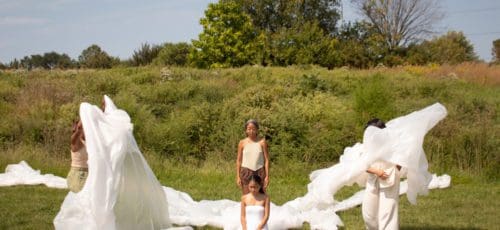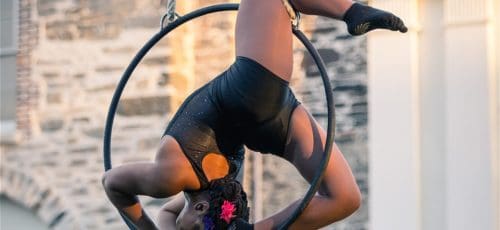Lovertits: Interview with Neighborhood Fringe artist Annie Wilson
 “Multiple climaxes, drifting off, getting exciting again, plateau-ing out, calming down, another climax, some snuggling.”
“Multiple climaxes, drifting off, getting exciting again, plateau-ing out, calming down, another climax, some snuggling.”
In a performance she describes as a “burlesque-postmodern-dance-theater-bad-improv,” Annie Wilson explores our societal views on sex and the real, messy, embodied sex that humans actually have. Lovertits will run at the Ruba Club (416 Green St) from Sept 19 to Sept 21 in this year’s Fringe Festival.
What was the inspiration to create Lovertits?
I made a piece in 2010 by the same name when I choreographed for a burlesque show presented by my company at the time, Pink Hair Affair. I wanted to poke fun at my understanding of burlesque at the time, as well as dance in general, which idealizes the body in a way that does not account for the plethora of experiences a body goes through, or the plethora of ways a body looks.
The way we perform sexiness both onstage and in real life is so disconnected from how we engage with the sex act. I mean we look like weird hairless animals when we copulate, and no amount of glitter is going to change that. Similarly, the way we are embodied when we cry, grieve, poop, put in a tampon, give birth, sit at a table, are very dissimilar from how they are generally performed in a dance concert. I was always bothered whenever I saw a dance about sadness or pain or grief that involved an athletic soloist performing several pirouettes or big leaps. Come on.
The underlying mantra for the piece is: Having a body is awesome. And having a female body is awesome. And what makes having a body awesome has so little to do with the way it looks. So how do we assert this in performance, which is based on presenting living imagery of the body?
Burlesque, and in my opinion, a great deal of culture, hews to a male trajectory of sex. I mean there’s titillation, arousal, and a climax (the big reveal of pasties and g-string). The female experience of sex is far more circuitous than that, and I am curious about creating a performance about sex that follows a female trajectory, with multiple climaxes, drifting off, getting exciting again, plateau-ing out, calming down, another climax, some snuggling. A theme of grief has also worked its way into the piece, and I am finding that the experience of grief has parallels with my experience of sex in its circular nature.
Why is it important to perform about sex?
I have often appreciated the connections between sex and creativity. In sex as in creativity, there are no wrong answers (assuming consensuality, of course). When making a show, as in engaging in sex, you are generally trying to reach an end goal (a performance or an orgasm, respectively), but the ways to get there are endless and there are detours, breaks, tangents, auxiliary acts, time spent thinking about it when not actually engaged in it. You get to connect with what feels good, both for you and the partner (or audience). Sex and art are both self-serving and generous acts, simultaneously. There are very satisfying parallels.
Of course, the contemporary American relationship to sex, and to the body, is deeply problematic and entrenched in shame. This is not new information. I think dance, as a field, is in a unique position to engage people’s bodies in ways that our society doesn’t normally allow. Everyone has a relationship to sex the way they have a relationship to food. As adults, we normally only think of nude bodies as sexual. I think dance is in a unique position to say to people looking for a deeper experience of life, “well, you know sex, right? And it’s awesome. There’s a whole world of bodily experience out there, that’s just as awesome.”
You have performed this before but are expanding Lovertits for this year’s Fringe Festival. What was that process like?
In reality, we’ve created enough material to fill a three-hour show. So the question has actually been more along the lines of: how do we collapse material? Which ideas are resonating with each other in the space and which ones live invisibly, in the rehearsal process but never make it onstage? Which parts speak directly to the questions we are asking, and which are tangential? You know, womanhood and sexuality and the performance thereof are such huge subjects, you could go on forever, but what specific slice do we want to illuminate in this moment?
What is your Festival image?
The image is actually an artist rendering of Tom Selleck if he were to play Mark Twain. Not sure who drew the image or why, as there’s no biopic of Mark Twain starring Tom Selleck as far as I’m aware. The image arose from an exercise in rehearsal one day where we asked ourselves what white male our clitoris would be, given the choice. One collaborator decided that it would be Mark Twain. So it started out as a funny image.
But one of the things that we are playfully subverting is the history of white dudes who project their idea of what women are onto women’s bodies. In the image, we are projecting a vagina onto the mouth of Tom Selleck-as-Mark Twain. And not just a vagina, an anatomically correct drawing of the clitoris, the anatomy of which has only really been discovered and explored in the past ten years. Ten years. How would our understanding of the world change if our clitorises could re-interpret the wealth of knowledge generated and published and put into history and anatomy books by white dudes?
Lovertits
Ruba Club
416 Green Street
Sept 19 at 8pm + 11:30pm
Sept 20 at 8pm + 10pm
Sept 21 + 22 at 9pm
$15
–Miriam Hwang-Carlos


